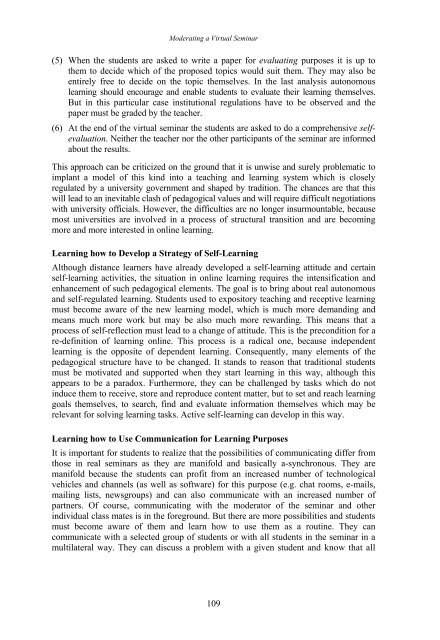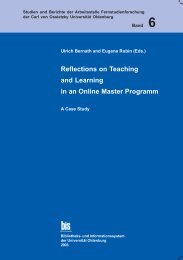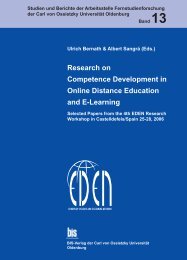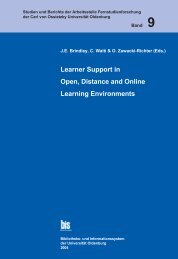Distance Education in Transition - Master of Distance Education ...
Distance Education in Transition - Master of Distance Education ...
Distance Education in Transition - Master of Distance Education ...
Create successful ePaper yourself
Turn your PDF publications into a flip-book with our unique Google optimized e-Paper software.
Moderat<strong>in</strong>g a Virtual Sem<strong>in</strong>ar<br />
(5) When the students are asked to write a paper for evaluat<strong>in</strong>g purposes it is up to<br />
them to decide which <strong>of</strong> the proposed topics would suit them. They may also be<br />
entirely free to decide on the topic themselves. In the last analysis autonomous<br />
learn<strong>in</strong>g should encourage and enable students to evaluate their learn<strong>in</strong>g themselves.<br />
But <strong>in</strong> this particular case <strong>in</strong>stitutional regulations have to be observed and the<br />
paper must be graded by the teacher.<br />
(6) At the end <strong>of</strong> the virtual sem<strong>in</strong>ar the students are asked to do a comprehensive selfevaluation.<br />
Neither the teacher nor the other participants <strong>of</strong> the sem<strong>in</strong>ar are <strong>in</strong>formed<br />
about the results.<br />
This approach can be criticized on the ground that it is unwise and surely problematic to<br />
implant a model <strong>of</strong> this k<strong>in</strong>d <strong>in</strong>to a teach<strong>in</strong>g and learn<strong>in</strong>g system which is closely<br />
regulated by a university government and shaped by tradition. The chances are that this<br />
will lead to an <strong>in</strong>evitable clash <strong>of</strong> pedagogical values and will require difficult negotiations<br />
with university <strong>of</strong>ficials. However, the difficulties are no longer <strong>in</strong>surmountable, because<br />
most universities are <strong>in</strong>volved <strong>in</strong> a process <strong>of</strong> structural transition and are becom<strong>in</strong>g<br />
more and more <strong>in</strong>terested <strong>in</strong> onl<strong>in</strong>e learn<strong>in</strong>g.<br />
Learn<strong>in</strong>g how to Develop a Strategy <strong>of</strong> Self-Learn<strong>in</strong>g<br />
Although distance learners have already developed a self-learn<strong>in</strong>g attitude and certa<strong>in</strong><br />
self-learn<strong>in</strong>g activities, the situation <strong>in</strong> onl<strong>in</strong>e learn<strong>in</strong>g requires the <strong>in</strong>tensification and<br />
enhancement <strong>of</strong> such pedagogical elements. The goal is to br<strong>in</strong>g about real autonomous<br />
and self-regulated learn<strong>in</strong>g. Students used to expository teach<strong>in</strong>g and receptive learn<strong>in</strong>g<br />
must become aware <strong>of</strong> the new learn<strong>in</strong>g model, which is much more demand<strong>in</strong>g and<br />
means much more work but may be also much more reward<strong>in</strong>g. This means that a<br />
process <strong>of</strong> self-reflection must lead to a change <strong>of</strong> attitude. This is the precondition for a<br />
re-def<strong>in</strong>ition <strong>of</strong> learn<strong>in</strong>g onl<strong>in</strong>e. This process is a radical one, because <strong>in</strong>dependent<br />
learn<strong>in</strong>g is the opposite <strong>of</strong> dependent learn<strong>in</strong>g. Consequently, many elements <strong>of</strong> the<br />
pedagogical structure have to be changed. It stands to reason that traditional students<br />
must be motivated and supported when they start learn<strong>in</strong>g <strong>in</strong> this way, although this<br />
appears to be a paradox. Furthermore, they can be challenged by tasks which do not<br />
<strong>in</strong>duce them to receive, store and reproduce content matter, but to set and reach learn<strong>in</strong>g<br />
goals themselves, to search, f<strong>in</strong>d and evaluate <strong>in</strong>formation themselves which may be<br />
relevant for solv<strong>in</strong>g learn<strong>in</strong>g tasks. Active self-learn<strong>in</strong>g can develop <strong>in</strong> this way.<br />
Learn<strong>in</strong>g how to Use Communication for Learn<strong>in</strong>g Purposes<br />
It is important for students to realize that the possibilities <strong>of</strong> communicat<strong>in</strong>g differ from<br />
those <strong>in</strong> real sem<strong>in</strong>ars as they are manifold and basically a-synchronous. They are<br />
manifold because the students can pr<strong>of</strong>it from an <strong>in</strong>creased number <strong>of</strong> technological<br />
vehicles and channels (as well as s<strong>of</strong>tware) for this purpose (e.g. chat rooms, e-mails,<br />
mail<strong>in</strong>g lists, newsgroups) and can also communicate with an <strong>in</strong>creased number <strong>of</strong><br />
partners. Of course, communicat<strong>in</strong>g with the moderator <strong>of</strong> the sem<strong>in</strong>ar and other<br />
<strong>in</strong>dividual class mates is <strong>in</strong> the foreground. But there are more possibilities and students<br />
must become aware <strong>of</strong> them and learn how to use them as a rout<strong>in</strong>e. They can<br />
communicate with a selected group <strong>of</strong> students or with all students <strong>in</strong> the sem<strong>in</strong>ar <strong>in</strong> a<br />
multilateral way. They can discuss a problem with a given student and know that all<br />
109





